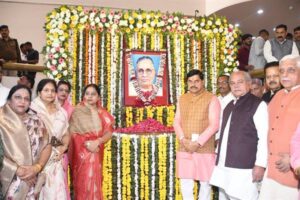Madhya Pradesh wins awards in two categories; CM Dr. Yadav congratulates winners

6th National Water Awards Announced
Also Leads in “Jal Sanchay, Jal Bhagidari” Initiative
President Smt. Droupadi Murmu to present awards on November 18
Bhopal : Tuesday, November 11, 2025: Madhya Pradesh has once again gain national recognition in water conservation. Union Minister for Jal Shakti, Shri C.R. Patil, announced the 6th National Water Awards in New Delhi on Tuesday. Madhya Pradesh received honours in two categories. Khargone district of Madhya Pradesh has been awarded as the best district in the eastern region, while the Kaveshwar Gram Panchayat of Khandwa district has jointly secured second place in the Best Gram Panchayat category.President Smt. Droupadi Murmu will present the awards on November 18, 2025.
Chief Minister Dr. Mohan Yadav has congratulated the awarded districts. Madhya Pradesh has also achieved a leading position in the Jal Sanchay, Jal Bhagidari” initiative. In the South Zone, East Nimar received the first prize in Category 1, while Guna was recognized among the top 50 urban bodies. In Category 3 for districts, Guna, Betul, Dhar, Dewas, Seoni, and Khargone secured the second rank.
It is noteworthy that under the Ministry of Jal Shakti, the Department of Water Resources, River Development, and Ganga Rejuvenation has announced a total of 46 winners for the 6th National Water Awards for the year 2024. These awards are presented in 10 categories — Best State, Best District, Best Gram Panchayat, Best Urban Local Body, Best School/College, Best Industry, Best Water Users Association, Best Institution (other than schools/colleges), Best Civil Society, and Best Individual for Excellence in Water Sector.
Under the guidance of Prime Minister Shri Narendra Modi, the Ministry of Jal Shakti has been running a nationwide campaign to promote awareness about water management and conservation.
With this objective, the National Water Awards were instituted in 2018 to raise awareness about the importance of water and to encourage the adoption of best practices for its use.
For the 2024 edition, the 6th National Water Awards were launched on October 23, 2024, through the National Awards Portal of the Ministry of Home Affairs. A total of 751 applications were received, which were reviewed and evaluated by an expert committee. The shortlisted applications were further examined by the Central Water Commission and the Central Ground Water Board. Based on their final reports, 46 winners were selected for the 2024 National Water Awards.
The objective of the National Water Awards is to recognize outstanding efforts by individuals and organizations and to realize the government’s vision of a “Water Prosperous India.” These awards aim to increase public awareness about the importance of water and to encourage people to adopt the best water-use practices. This initiative also strengthens partnerships and public participation in water resource conservation and management activities.
Madhya Pradesh also leads in Jal Sanchay, Jal Bhagidari” Initiative
Under the Catch the Rain campaign, East Nimar received the first prize in Category 1 of the South Zone, Guna was recognized among the top 50 urban bodies, and Guna, Betul, Dhar, Dewas, Seoni, and Khargone were selected for the second rank in Category 3 among districts.
Under this initiative, states have been divided into five zones, and districts were encouraged to create a minimum of 10,000 artificial groundwater recharge and storage structures. For northeastern and hilly districts, the target was 3,000 structures, and for municipal corporations across the country, the target was 10,000 structures. These include rainwater harvesting systems, as well as revival of lakes, ponds, and stepwells.
To strengthen urban water conservation efforts, the Ministry of Housing and Urban Affairs partnered with the Ministry of Jal Shakti, motivating urban local bodies to build at least 2,000 recharge structures.
This year, a total of 100 awards have been announced, including 3 Best States, 67 Districts, 6 Municipal Corporations, 1 Urban Local Body, 2 Partner Ministries/Departments, 2 Industries, 3 Non-Governmental Organizations, 2 Philanthropists, and 14 Nodal Officers.





